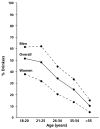The alcohol hangover research group consensus statement on best practice in alcohol hangover research
- PMID: 20712593
- PMCID: PMC3827719
- DOI: 10.2174/1874473711003020116
The alcohol hangover research group consensus statement on best practice in alcohol hangover research
Abstract
Alcohol-induced hangover, defined by a series of symptoms, is the most commonly reported consequence of excessive alcohol consumption. Alcohol hangovers contribute to workplace absenteeism, impaired job performance, reduced productivity, poor academic achievement, and may compromise potentially dangerous daily activities such as driving a car or operating heavy machinery. These socioeconomic consequences and health risks of alcohol hangover are much higher when compared to various common diseases and other health risk factors. Nevertheless, unlike alcohol intoxication the hangover has received very little scientific attention and studies have often yielded inconclusive results. Systematic research is important to increase our knowledge on alcohol hangover and its consequences. This consensus paper of the Alcohol Hangover Research Group discusses methodological issues that should be taken into account when performing future alcohol hangover research. Future research should aim to (1) further determine the pathology of alcohol hangover, (2) examine the role of genetics, (3) determine the economic costs of alcohol hangover, (4) examine sex and age differences, (5) develop common research tools and methodologies to study hangover effects, (6) focus on factor that aggravate hangover severity (e.g., congeners), and (7) develop effective hangover remedies.
Figures




References
-
- Ylikahri RH, Huttunen MO, Eriksson CJP, Nikkilä EA. Metabolic studies on the pathogenesis of hangover. Europ J Clin Invest. 1974;4:93–100. - PubMed
-
- Verster JC. The alcohol hangover: a puzzling phenomenon. Alcohol Alcohol. 2008;43:1–3. - PubMed
-
- Stephens R, Ling J, Heffernan TM, Heather N, Jones K. A review of the literature on the cognitive effects of alcohol hangover. Alcohol Alcohol. 2008;43:163–70. - PubMed
-
- Prat G, Adan A, Sanchez-Tuert M. Alcohol hangover: A critical review of explanatory factors. Hum Psychopharmacol Clin Exp. 2009;24:259–67. - PubMed
-
- Verster JC, Van Herwijnen J, Olivier B, Kahler CW. Validation of the Dutch Brief Young Adult Alcohol Consequences Questionnaire (B-YAACQ) Addict Behav. 2009;34:411–4. - PubMed
Publication types
MeSH terms
Grants and funding
LinkOut - more resources
Full Text Sources
Other Literature Sources
